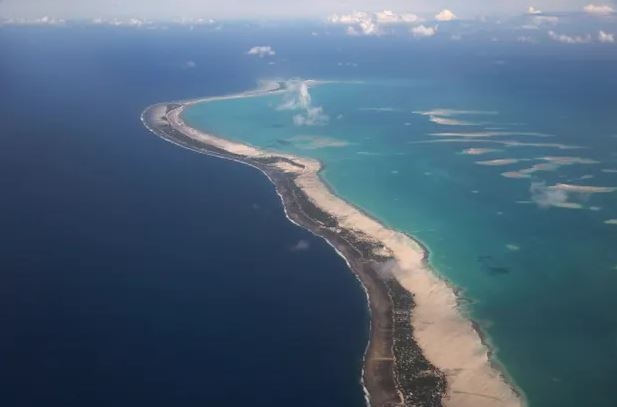The migraine of migration: the tiny island-nation of Kiribati struggles for survival
April 13, 2021

By Karen Zhang
Many residents of destination countries consider immigrants a headache at best and a threat at worst. Yet the perils of migration are much more painful for those who are forced into them. Whether immigrants arrive via legal or illegal channels, they often begin their pursuit of happiness in a newfound land encountering discrimination.
In Kiribati, a remote island country in the equatorial Pacific, migration of I-Kiribati, as its people call themselves, has taken place as a result of rising sea levels. Half of the country’s population of 111,000 people lives in South Tarawa, the capital and hub of Kiribati. The rapidly growing urban area is less than 9.8 feet (3 meters) above sea level, and yet Tarawa has an extremely high population density. Generally, the reasons for people to relocate can be divided into the categories of economic migration or non-economic migration (such as political asylum, war, and drought). Kiribati certainly fits the bill for both.
Seeking opportunities abroad, against hostility and prejudice
Kiribati is recognized as a Least Developed Country (LDC) and is ranked 170th of 186 countries on per capita GDP, according to an official paper. The economy is highly dependent on fishing licensing fees, remittances, and donor assistance. Until 1979, the phosphate rock mining industry contributed a large reserve fund with growing interest to the government. Still, along with the challenges of an increased population and rapid urbanization that are commonly seen in many other developing countries, Kiribati has to deal with alarmingly high rates of unemployment, and infant mortality resulting from insufficient healthcare.
Global warming aggravates this outgoing labor force. The sandy, tropical islands have few natural resources and are prone to drought. Joshua Keating, author of Invisible Countries, poses a poignant question: “Countries cannot be destroyed; they can only become other countries, the land they occupy now controlled by someone else. But what if there is no more land?”
As glaciers are melting, warm seawater and overfishing are bleaching coral reefs, further damaging the food chain as high up as humans. Land erosion has driven the I-Kiribati to move to higher ground or even relocate abroad. The term “climate refugees'' originates from a headline-making lawsuit surrounding I-Kiribati Ioane Teitiota. Mr. Teitiota brought a case against the government of New Zealand at the UN Human Rights Committee (HRC) in February 2016 after authorities denied his claim of asylum as a “climate refugee.” He had been deported from New Zealand to Kiribati six months before.
Early in January 2020, in its first ruling on climate change-related asylum seeking, the HRC stated that countries may not deport individuals who face climate change-induced conditions that violate the right to life. The landmark decision surely sets a global precedent. To developed countries, an influx of climate refugees reaching ashore to enter their boundaries of sovereignty may be akin to a migraine, especially to xenophobic leaders and citizenry.

The beginning of an end of climate diplomacy
Kiribati is only an example of the international and internal crisis that is confronted by low-lying countries and coastal communities around the world. Because most of this tropical country is only at Michael Jordan’s height (approx. 2 meters) above sea level, it is prone to be one of the first countries that will be wiped off the world map as a result of rising sea levels and land erosion. In fact, Kiribati is so small that you can barely see it on a map now.
It is a known fact that climate change displaces wildlife and humans. When Hurricane Katrina hit Louisiana, tens of thousands of people had to be evacuated and relocated, and some even resettled elsewhere permanently. As the planet warms, species are shifting where, when, and how they thrive. According to National Geographic citing a federal study, half of all species are on the move. Fishery communities will be hard hit, as they depend on certain kinds of marine commodities for livelihoods. Kiribati may have a shrinking land area but it has one of the world’s largest maritime Exclusive Economic Zones (EEZ). However, bathed in the cruelty of global warming and marine pollution, schools of fish, including tuna—Kiribati’s largest economic resource—may migrate toward cooler waters or die together with the bleaching coral reef. That’s a migraine to the fishing industry.
Status stigma
To Pacific Islanders, being labeled as “climate refugees” connotes a stigma equivalent to being second-class citizens. During Anote Tong’s presidency (2003–2016), the government launched the “migration with dignity” policy to allow I-Kiribati to apply for jobs offered in neighboring countries such as New Zealand. Educated young I-Kiribati seem to be more receptive to the policy than their parents or grandparents, who would rather live and die where they were born. Researchers shed light on one projection that a 19.7-inch (50 centimeter) rise in sea level could displace 1.2 million people from low-lying islands in the Caribbean Sea and the Indian and Pacific Oceans. That number almost doubles if the sea level rises by two meters.
When ethnic groups are disbanded and displaced, their culture, including languages, is susceptible to assimilation with new culture or being gradually lost over generations. If this is not a migraine-turned-terminal-illness in linguistics, what is?

Karen (Songyi) Zhang grew up in the southeastern Chinese city of Guangzhou, formerly known as Canton. Her essays and op-ed articles have appeared in various publications in China and the U.S., and she authored the memoir "Golden Orchid: The True Story of an Only Child in Contemporary China." She received her M.F.A. in Creative Writing from Chatham University in Pittsburgh. Karen has worked for the Washington-based Radio Free Asia as an administrator, broadcaster, and translator. With deep passions for language and the environment, Karen plans to join global efforts to promote sustainable development with her newly acquired knowledge in the field. She graduated from Virginia Tech’s Executive Master of Natural Resources (XMNR) program in 2020.


